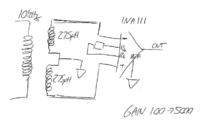emsensors
Junior Member level 3
Hi,
I am using a INA111 Instrumentation Amplifier with gain in the range 100 to 3000. The input consists of two fairly well matched coils symmetric about a driver operating at 10 kHz. The coils have an impedance of maybe 20 Ohms or so and 3 Ohms DC resistance. So, the setup is kind of like an LVDT. The coils are connected in such a way as to null when there is no 'displacement' - see figure. I am observing some gain drift with temperature and despite a lot of research I cannot find a good resource that will help me solve this problem. So, two questions... 1) Anybody got any suggestions as to how I could go about trimming this temperature coefficient of gain? 2) Anybody know of any good resources (print or online) that discusses temperature compensation in general or with an emphasis on op-amp circuits?
Many thanks!

I am using a INA111 Instrumentation Amplifier with gain in the range 100 to 3000. The input consists of two fairly well matched coils symmetric about a driver operating at 10 kHz. The coils have an impedance of maybe 20 Ohms or so and 3 Ohms DC resistance. So, the setup is kind of like an LVDT. The coils are connected in such a way as to null when there is no 'displacement' - see figure. I am observing some gain drift with temperature and despite a lot of research I cannot find a good resource that will help me solve this problem. So, two questions... 1) Anybody got any suggestions as to how I could go about trimming this temperature coefficient of gain? 2) Anybody know of any good resources (print or online) that discusses temperature compensation in general or with an emphasis on op-amp circuits?
Many thanks!
